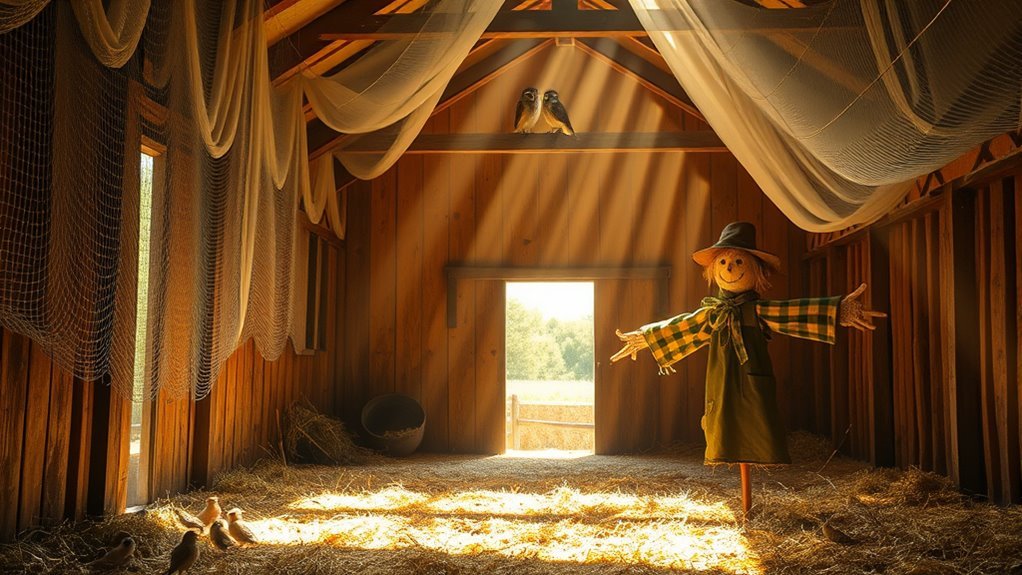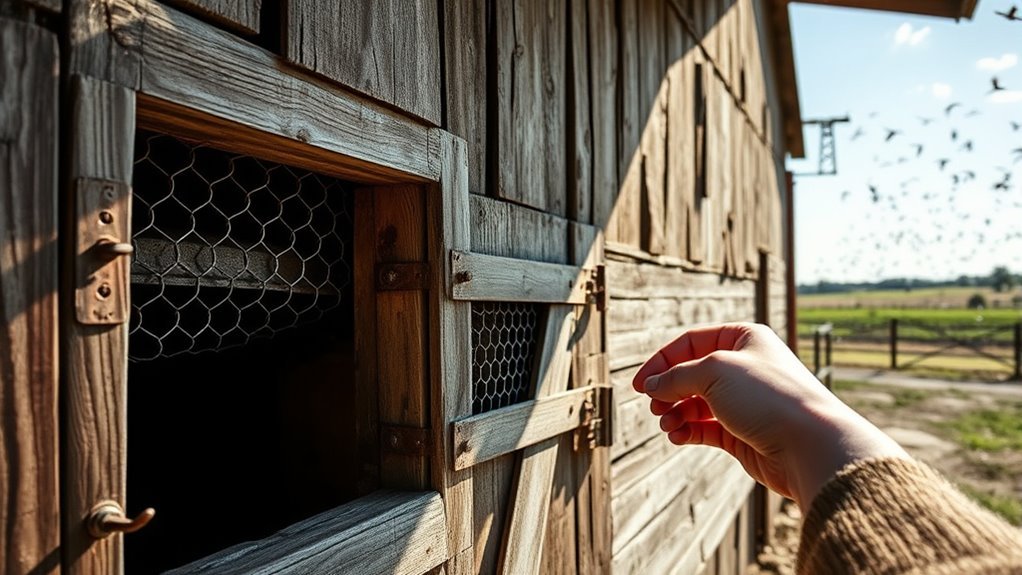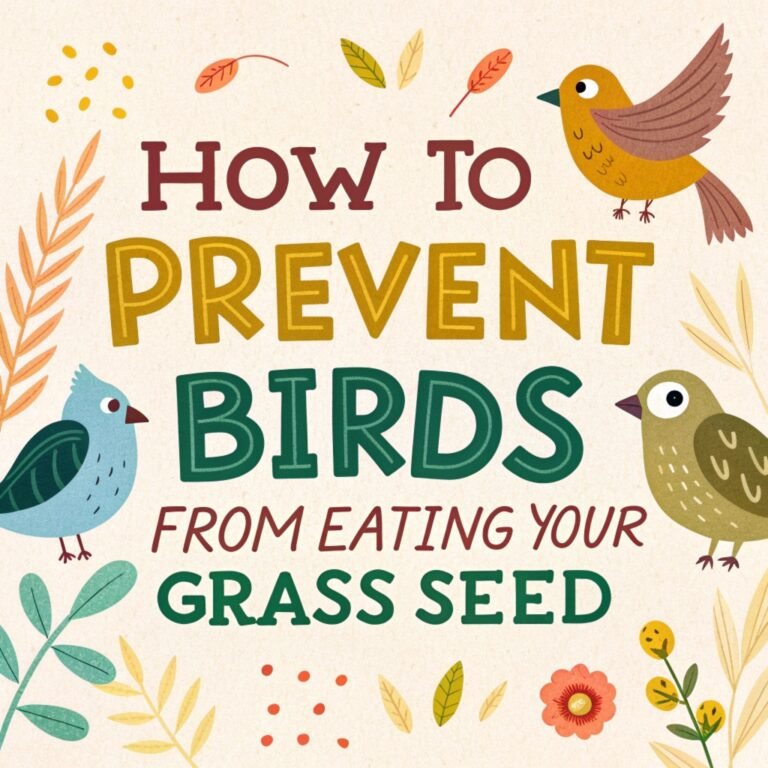How to Keep Birds Out of Barns and Other Structures
If birds are entering your barn or other structures, you need to address the issue step by step. First, identify the bird species that pose a threat and their preferred nesting locations. Recognize where they might enter and where they could nest. This will help you keep them out. Next, implement effective sealing methods and use deterrents to discourage birds from coming in.
Key Takeaways
- Seal entry points by inspecting and repairing cracks, gaps, and holes in walls, doors, and windows using strong materials.
- Identify and remove potential nesting areas such as beams, ledges, and corners to deter birds from settling.
- Implement visual deterrents like reflective objects, natural predator decoys, and noise-making devices to scare birds away.
- Maintain a clean environment by regularly cleaning droppings, removing nesting materials, and securely storing trash and feed.
- Regularly check and clean gutters and roofs to prevent water buildup and discourage birds from roosting.
Understanding Common Bird Species in Barns

To keep birds out of barns, it's important to know the common species that might enter. You'll often find swallows, pigeons, and sparrows in these spaces. Each species has unique behaviors and nesting seasons.
Swallows typically arrive in the spring and look to build nests. Pigeons often roost in barns year-round, while sparrows generally nest during the warmer months.
By observing their habits, such as where they feed and how they build nests, you can take steps to deter them. For example, swallows prefer open areas, so you can identify and seal off entry points.
Knowing their seasonal patterns can help you anticipate when they'll return and allow you to act before they settle in. This knowledge gives you more control over your barn space and creates a more comfortable environment for both you and your animals.
Identifying Potential Nesting Areas
To find bird nesting areas in your barn, observe the habits of common bird species.
Look for potential nesting spots like beams, ledges, or corners that provide shelter. Birds choose safe spaces that protect them from weather and predators.
Gather any available nesting materials, such as straw or twigs, which they may use.
Identify roosting sites, as these can indicate where birds might nest.
Check for areas with droppings, since this often means birds are active there.
Sealing Entry Points Effectively

To keep birds out of your barn, start by sealing all entry points. Look for cracks, gaps, and holes in the walls, doors, and windows. Use strong materials like metal mesh, wood panels, or heavy plastic to block these openings.
Make sure to apply weatherproof sealing to protect against water damage and temperature changes. Pay attention to ventilation systems, as they can easily be missed.
Implementing Deterrents and Scare Tactics
Sealing entry points is important, but adding deterrents can improve your barn's defense against unwanted birds.
These tactics help keep birds away and connect you with other livestock owners who face the same issues.
Here are four simple deterrents to consider:
- Visual Deterrents: Hang reflective objects like old CDs or aluminum foil. They confuse birds and discourage them from entering.
- Natural Predators: Use decoys of hawks or owls. These can scare off smaller birds looking for shelter.
- Sound Devices: Install noise-making devices or play recordings of predator calls. The sounds can deter birds from approaching.
- Physical Barriers: Use scare balloons that move in the wind. Their movement can frighten birds away.
Utilizing Netting and Screens

After applying deterrents, using netting and screens is a practical method to keep birds out of your barn.
Start by selecting netting materials such as polyethylene or polypropylene. These materials create strong barriers without endangering the birds. Install netting where birds often enter, like vents or eaves.
For doors and windows, use sturdy screens made from metal or heavy-duty fiberglass. These screens allow airflow while blocking bird access.
Regularly inspect for tears or signs of wear, as maintaining these barriers is crucial.
Maintaining a Clean Environment
Keeping your barn clean is important to keep birds away and prevent pest problems. A tidy space helps your livestock and discourages unwanted visitors.
Here are four easy steps to maintain cleanliness:
- Clean up bird droppings regularly to remove breeding spots.
- Take out nesting materials found in corners and equipment to make it difficult for birds to settle.
- Store trash and feed securely to minimize food sources for birds.
- Check and clean gutters and roofs to avoid water buildup that attracts birds.
Following these steps ensures a clean environment for your animals and reduces the risk of bird infestations.
Landscaping for Bird Control
Landscaping can effectively keep birds away from your barn. Using native plants makes the area less attractive to birds. Native plants grow well in your local environment and need less care.
Modify the area around your barn by reducing open spaces where birds can perch or nest. Plant shrubs and trees to obstruct their view and discourage them from roosting nearby.
Also, make sure to store compost and feed away from the barn's edges to eliminate food sources.
These landscaping steps not only beautify your property but also help ensure your barn stays free of birds. Your efforts in creating a harmonious environment will make a meaningful impact!
Installing Sound and Light Devices
To improve your bird control strategy, you can install sound and light devices around your barn. These devices create an uninviting space for birds by changing sound frequency and light intensity.
Here's how to use them effectively:
- Ultrasonic Devices: These devices produce high-frequency sounds that birds dislike, keeping them away.
- Recorded Bird Calls: Playing the calls of predators can scare off unwanted birds.
- Flashing Lights: Use adjustable lights to confuse birds and make them uncomfortable.
- Motion Sensors: These sensors trigger sounds or lights when birds approach, startling them and preventing nesting or roosting.
Incorporating these methods can significantly reduce bird activity around your property and protect your barn.
Seeking Professional Help When Necessary
If your bird control efforts aren't working, it may be time to consider getting professional help.
Bird control experts can provide you with effective strategies to manage the situation. They know how to identify bird species, understand their behavior, and apply effective solutions.
Pest management services can improve your efforts by using advanced techniques and tools.
They'll look at your barn's specific needs, create preventive measures, and provide ongoing support.
Investing in professional help protects your structure and benefits your livestock and environment.
Don't hesitate to reach out for assistance; it's a positive step toward a bird-free space.
Frequently Asked Questions
What Are the Best Times of Year for Bird Prevention Measures?
To effectively implement bird prevention measures, focus on spring and late summer. These seasons see increased bird migration, making them ideal times to address potential intrusions. By acting during these periods, you can keep your space secure and welcoming for your activities.
Can Birds Return After Prevention Methods Are Implemented?
Yes, birds can come back even after you use prevention methods. They are very adaptable, which can make your efforts challenging. To improve your results, watch how well your methods work and make changes as needed. This can also help create a friendly space for other animals.
Are There Humane Ways to Remove Birds From Structures?
You can use non-lethal traps and nesting deterrents to remove birds from structures without harming them. These methods help birds find new homes safely, allowing you to resolve your bird issues while protecting their well-being. Simple and effective, these solutions support a peaceful coexistence between humans and birds.
How Long Does It Take to See Results From Deterrents?
You will usually see how well deterrents work in a few weeks. If you continue to face issues, you may need to change your approach. Being patient and flexible will help you succeed in keeping unwanted birds away.
Are There Specific Bird Species That Are Harder to Deter?
Sparrows are often difficult to deter because they quickly adapt to different methods. Pigeons also pose a challenge due to their persistence, requiring a variety of strategies to effectively manage them. Knowing these behaviors can help you create a more effective bird control plan.

Hello, I’m Amelia White, the founder of birdsfanatic.com. As a lifelong bird enthusiast and spiritual seeker, I’ve always been fascinated by the mystical connections between birds and the human experience. On this site, I share my knowledge and insights into the symbolic meanings and spiritual significance of various bird species, exploring their roles in mythology, folklore, and cultural traditions. Join me on this journey into the world of birds, where we’ll discover the hidden wisdom and guidance that these magnificent creatures have to offer.







